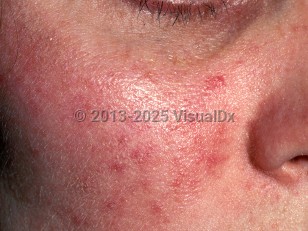The etiology of rosacea is incompletely understood but likely involves dysregulation of immune and neurocutaneous mechanisms. Cutaneous vascular changes, ultraviolet (UV) and microbial exposure (ie, Demodex mites, Bacillus oleronius, and Staphylococcus epidermidis), and disruption of the epidermal barrier have all been implicated as playing a role in the pathogenesis in this condition. There have been reports of familial rosacea, so an underlying genetic predisposition has not been ruled out. In fact, rosacea has been found to be associated with single nucleotide polymorphisms in genes coding for major histocompatibility complex (MHC).
Rosacea primarily affects individuals with lighter skin phototypes, namely those of northern European and Celtic descent. In individuals with darker skin colors, rosacea may be underdiagnosed due to difficulty in discerning erythema and telangiectasias. Rosacea has been found to have no sex predilection, in contrast to previous studies noting a female predominance.
According to the American National Rosacea Society, there are 4 main subtypes of the disease: erythematotelangiectatic, papulopustular, phymatous, and ocular rosacea.
- Erythematotelangiectatic rosacea – Presents with persistent erythema of the central portion of the face with intermittent flushing. Telangiectasias are present in most individuals. Patients often mention stinging or burning sensations on the skin. This is the most common subtype.
- Papulopustular rosacea – Presents with variable intensity of central facial erythema with relative sparing of the periocular areas and a variable number of acneiform papules and pustules. Dramatic swelling can result in lymphedematous changes manifesting as solid facial edema or lead to phymatous changes.
- Phymatous rosacea – Chronic inflammation and edema result in marked thickening of the skin with sebaceous hyperplasia, resulting in an enlarged, cobblestoned appearance of affected skin, most commonly on the nose (rhinophyma). Men are more often affected. Less commonly, phymatous rosacea can affect the ears (otophyma), chin (gnatophyma), forehead (metophyma), or eyelids (blepharophyma).
- Ocular rosacea – Symptoms of mild ocular rosacea include gritty sensation, dryness, tearing, and itching of the eyes. Styes occur frequently. More active ocular rosacea can present as blepharitis, lid margin telangiectasia, and conjunctival injection.
Patients can present with characteristics of more than one subtype. More than half of patients with rosacea present with ocular symptoms.
Diagnostic criteria for rosacea were ratified in 2017 by the global ROSacea Consensus (ROSCO) panel and subsequently approved by the American National Rosacea Society. Two features were identified as being independently diagnostic for rosacea: phymatous changes and persistent centrofacial erythema with periodic intensification by potential trigger factors. In their absence, 2 or more major features and some minor features can be used to establish the diagnosis. Major features are flushing / transient centrofacial erythema, telangiectasia, inflammatory papules / pustules, and ocular manifestations. Minor features are burning, stinging, and dry sensation of the face and edema.
Since rosacea manifests on the face, it is important to recognize that this disease can have psychosocial consequences, which may affect quality of life and social and psychological wellbeing.



 Patient Information for
Patient Information for 
